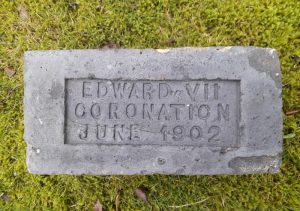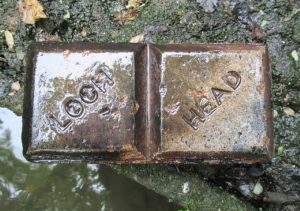Canmore
Cleghorn Brickworks, Cleghorn, Lanarkshire.
16/11/1895 – Glasgow Herald – The following Companies were registered in Edinburgh during the past week – 3039 – The Cleghorn Terra Cotta Co Ltd established with a capital of £25,000 divided into 2500 shares of £10 each, to carry out an agreement with Mark Hurll, brick manufacturer, Glasgow and to carry on the business of manufacturers and sellers of bricks, tiles, terracotta goods etc. The registered office is at 95 Bath Street, Glasgow. The subscribers are Robert M Wilson, Coalmaster, Glasgow. James S Dixon, Engineer, Glasgow; E.F Duvoisin, fireclay manufacturer, Glasgow, Charles R Cowie, merchant, Glasgow; Alexander Hurll, merchant, Glasgow; Charles Russell, iron merchant, Glasgow; John Fullarton, do.
Below – 1896 – Cleghorn Terracotta Brickworks.

1896 – 1897 – Cleghorn Terra Cotta Co Ltd, Terra Cotta facing bricks, roofing and flooring tiles, ridging, chimney pots etc. blue building and facing bricks etc. Works Cleghorn; Offices 144 West Regent Street, Glasgow. Telegraphic address ‘Hurll Glasgow’.
12/09/1896 – Dumfries & Galloway Courier and Herald – We understand that Mr R. Lancaster, who has acted as manager at the Messrs Brodie’s Brick and Tile Works, Sanquhar for some years, has been appointed to a superior post under the Cleghorn Terra Cotta Company Limited, Lanark.
20/05/1898 – Hamilton Herald – Evictions … Another action was at the instance of the Terra Cotta Brickworks Company, the offices of which are situated at 144 West Regent Street, Glasgow against William Hutton, engineer, Cleghorn Terra Cotta Brickworks. It was stated that his rent amounted to 2s 6d per week which was deducted from his wages. The sheriff allowed him a week in which to remove.
May 1899 – The British Clay Worker – For sale, Cummers patent revolving continuous drier, suitable for clay. Price £120. Nearly new. The Cleghorn Terra Cotta Co Ltd, Glasgow.
11/08/1900 – Glasgow Herald- New Scottish companies … No 4599. New Cleghorn Terra Cotta Company Limited, 93 Hope Street, Glasgow. Capital £15,000 in £1 shares. Formed to adopt an agreement with the existing company of that name which has its registered office at 144 West Regent Street, Glasgow. Signatories – David Rankine, civil engineer, 23d West George Street; John Faill, contractor, 52 Robertson Street; A K Foote, secretary, Kelvinside Brick Company Limited, 93 Hope Street; John A Todd, solicitor, 190 West George Street; James S Dixon, coal master, 127 St Vincent Street; Mark Hurll, brick manufacturer, 144 West Regent Street, all in Glasgow and J F Baird, brick manufacturer, Greenock Road, Paisley.
1901 – Directory of Clayworkers – New Cleghorn Terra Cotta Company Limited, 93 Hope Street, Glasgow. Terra cotta goods and all kinds of bricks. Works: Cleghorn near Lanark. T. add:’Pressed Glasgow’. Tel: 4054.
Below – 1901 – Census detailing employees of the Cleghorn Terracotta Brickworks.

1901 – 1902 – The New Cleghorn Terra Cotta Co Ltd. Finest red facing bricks, blue and brindled bricks, chimneypots, flooring tiles etc. Office – 93 Hope Street, Glasgow. Telegrams – ‘Pressed’ Glasgow and ‘Cleghorn Brickworks, Lanark’
Below – 16/07/1902 – The Aberdeen Daily Journal – Highland and Agricultural Show – Stand 155 contains a large number of ornamental vases, flowerpots and examples of the most up to date sanitary ware from the Seaton Brick and Tile Company, Aberdeen. Of special interest in the stand however is the exhibition of goods from the new Cleghorn Terra Cotta Company Limited, 93 Hope Street, Glasgow for which the Seaton Brick and Tile Company are the sole agents in this part of the country. The exhibit takes the form of a castle built of the highly finished bricks for which the Cleghorn Company is noted, together with the special bricks used for the paving of stable floors, mansion houses, courts and railway platforms etc. The goods manufactured by this company especially commend themselves for use to architects, builders and others having to do with the erections of buildings and should be seen by them. Up until 10 years ago the class of terra cotta bricks now being made by the company had been made solely in England, but from the style of the exhibits made in Lanarkshire the terra cotta making industry has come to stay in Scotland. Aberdeen School Board now uses terra cotta bricks of this company in various important contracts.

Below – 04/09/1903 – Hamilton Herald – Footbridge built over the River Mouse by Cleghorn Terra Cotta Co for the convenience of their workers.

1904 – 1905 – Cleghorn Terra Cotta Co Ltd. Finest red facing bricks, blue and brindled bricks, chimney cans, roofing, ridge and flooring tiles etc. Office – 45 Hope Street, Glasgow. Telegrams – ‘Pressed’ Glasgow and ‘Cleghorn Brickworks, Lanark’
1905 – 1906 – Cleghorn Terra Cotta Co Ltd. Finest red facing bricks, blue and brindled bricks, chimney cans, roofing, ridge and flooring tiles etc. Office – 45 Hope Street, Glasgow. Telegrams – ‘Pressed’ Glasgow and ‘Cleghorn Brickworks, Lanark’
12/01/1907 – Carluke and Lanark Gazette – A small article on Kilncadzow school with regards an issue with Mr Findlater, Headmaster looking for assistance in paying for a house as there was not a schoolhouse with his job … Mr Grossart said the school was certainly small, and if by any chance the Terra Cotta works at Cleghorn stopped, then many families would be removed from the district and the attendance would decrease …
12/12/1908 – Carluke and Lanark Gazette – A small article on Kilncadzow school in which there is the following reference … Mr Grossart said that with the re-opening of the Terra Cotta Works at Cleghorn they hoped for an increased number of scholars …
1908 – 1909 – Alexander K Foote – Brick Manufacturer, Cleghorn Terracotta Co Ltd. Ho Larkhall, Newlands. p252
1909 – 1910 – Cleghorn Terra Cotta Co Ltd. Finest red facing bricks, blue and brindled bricks, chimney cans, roofing, ridge and flooring tiles etc. Office – 45 Hope Street, Glasgow. Telegrams – ‘Pressed’ Glasgow and ‘Cleghorn Brickworks, Lanark’
Below – 1910 – Cleghorn Terracotta Brickworks
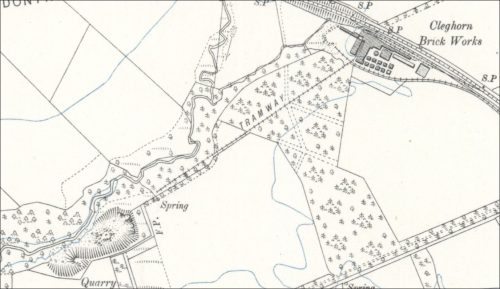
Below – 20/08/1910 – Falkirk Herald – Measuring House, Bannockburn Waterworks discussion whether to use Accrington, England bricks or Cleghorn Terra Cotta bricks.

1914 – 1918 – A reference in a 1983 guidebook (Title unknown) states that bricks made at Cleghorn were used in the construction of the boilers of the Dreadnought warships during WW1. ( Note – this is intriguing as I am only aware of fire bricks being used in the construction of boilers and I am not aware that Cleghorn made fire bricks).

09/09/1916 – Hamilton Advertiser – Clerk junior – one or two years experience. Wanted at once. Apply in own handwriting. Good wage is given to a suitable applicant. Apply Manager, Terra Cotta Works, Lanark (Cleghorn ?)
31/07/1917 – Daily Record – The death was reported yesterday of Mr John F Baird, Edgehill, Castlehead, Paisley who was well known in Glasgow and local business circles and had been for a time a director of the United Collieries Company, the Kelvinside Brick Company, the Cleghorn Terracotta Company Limited besides having been managing director at Speirs, Gibb & Company’s Paisley works and for a period chairman of Messrs McGee Ltd, Engineers. He was a member of the Parish Council and for a period chairman.
Below – 16/11/1918 – The Scotsman – Cleghorn Terracotta Company Limited in liquidation.

26/11/1920 – Carluke and Lanark Gazette – Brick making and house building. Captain Walter E. Elliot, M.C., M.P, speaking in the House of Commons on Thursday last week in connection with Unemployment Relief Work … Within what might be called a comparatively recent period no less than, five brickworks in Lanark and Carluke districts have ceased work and not always for the want of raw material. Messrs Macdonald’s Brickwork at Braidwood was permitted to stop and later be dismantled with a wealth of brickmaking material at hand in the shape of the Mayfield Blaes Hill. The dismantling of Cleghorn Terra Brickworks with their great capacity for brick production is now fast coming to a finish. Instead of allowing this brick machinery to be reduced to scrap iron and the kilns to heaps of loose bricks, could not the Government have taken over these works and used them in connection with their housing schemes? The five brickworks referred to had alone a producing capacity of at least 150,000 bricks per day.
27/05/1921 – Carluke and Lanark Gazette – Messrs Dewar and Finlay of Cleghorn Terracotta Company Limited applied for an order of ejectment against one of the tenants occupying the houses at Cleghorn Terra Cotta Works Cottages. This was following a dispute between neighbours and a complaint about one of them owning an annoying dog. His Lordship dismissed the case.
26/09/1921 – The Scotsman – Bricks and tiles – Offers are invited for the bricks and tiles on the ground at Cleghorn lately occupied by the Cleghorn Terra Cotta Company. There is a considerable quantity of new bricks of special sizes and designs and roof tiling and ridging together with over 500,000 used bricks capable of being cleaned. The offerers will give facilities for removal.
… Further upstream where the Fulwood Burn meets the Mouse Water, is the site of another old mill, Cunning Willie’s Mill – only the lade of the mill is now visible. This mill diverted water from the stream itself to power a mill wheel. Continuing upstream is another lade from the Blacking Mill. This mill is said to have been used by a firm called ‘Terra Cotta Brickworks’ to provide power for their factory. Bricks from the works can be seen in the path to the red bridge at Leitchford. This route formed part of the Ayr to Edinburgh road and would have been used by workers coming to the works from Lanark. The Cleghorn Mill, no longer visible, was used to grind charcoal for the foundries of the industrial age.
Click on the link for a slide show of pictures and maps related to the Cleghorn Terracotta Works. An excellent compilation which I believe was created by Paul Archibald of the Lanark Library. Slide show
Below – >1918 – SCRAN – A photograph of the Cleghorn Brickworks dated after closure 1918.

Below – photos of the only remaining standing brickwork on site. It appears to be a foundation or platform for heavy machinery and is situated next to where the railway siding and platform appears to have been. ( 04/04/2016)

.
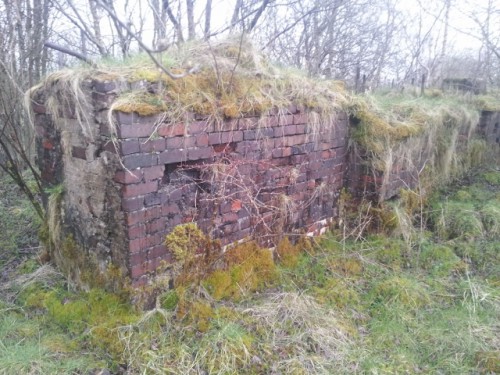
.

.
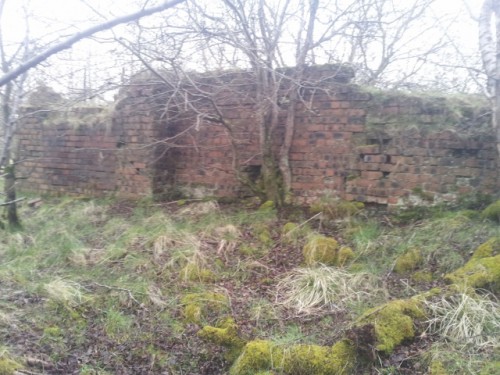
1900 – F.R & C.H Luke & Co, Slate Quarry Owners & General Factors for Building Materials – Sole agents for the East and South of Scotland for the Cleghorn Terracotta Co Ltd – bricks and tiles etc
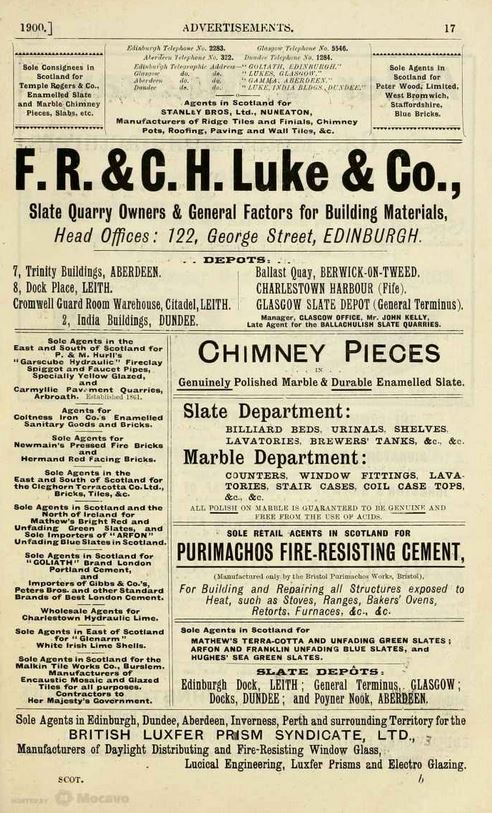
22/10/1918 – The Edinburgh Gazette – The Cleghorn Terra Cotta Company Limited. At an Extraordinary General Meeting of the Members of the above Company, duly convened, and held at 45 Hope Street, Glasgow, on the 25th day of September 1918, the following Special Resolutions were duly passed and at a subsequent Extraordinary General Meeting of the above Company, also duly convened, and held at the same place on the 16th day of October 1918, the following Special Resolutions were duly confirmed:—
1. “That The Cleghorn Terra-Cotta Company Limited be wound up voluntarily,” and
2. “That Mr William McLintock, Chartered Accountant, Glasgow is hereby appointed liquidator to conduct the winding up.”
David Rankine, Chairman.
Below – The now-demolished Rispin Viaduct, Leadhills was faced with a variety of Cleghorn bricks, some of which can still be seen lying in situ.

.
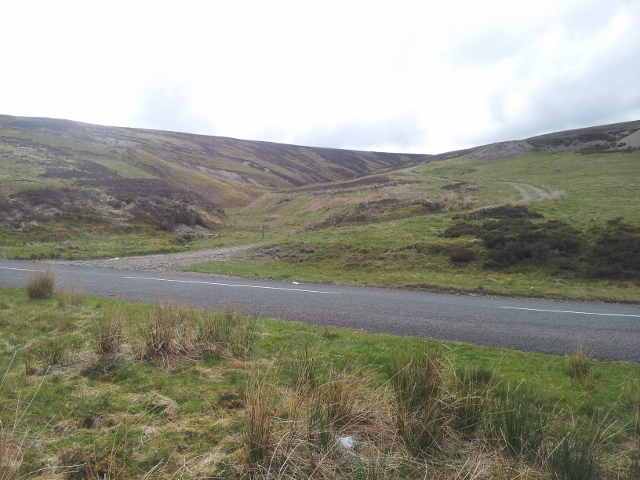
Below – The following bricks were found on-site by Mathias Lupton and will no doubt be products of the works. One example is stamped in raised letters ’29’. Another shows what appears to be ‘¾’ as part of the stamp and the last photo is of an unmarked diamond design paver or stable block.

.

.

Below – A section of probable garden edging. This is believed to be a Cleghorn product although it is not stamped. It was found by Tom Gillespie in a garden in the Lanark area alongside Cleghorn stamped bricks. (Note – SBH – Does anyone know the reason why the corners on the bottom side of the edging are cut away)?

.

























